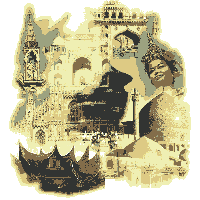|
World Heritage is the shared wealth of humankind. Protecting and preserving this valuable asset demands the collective efforts of the international community. This special day offers an opportunity to raise the public's awareness about the diversity of cultural heritage and the efforts that are required to protect and conserve it, as well as draw attention to its vulnerability.
 On 18 April 1982 on the occasion of a symposium organised by ICOMOS in Tunisia, the holding of the "International Day for Monuments and Sites" to be celebrated simultaneously throughout the world was suggested. This project was approved by the Executive Committee who provided practical suggestions to the National Committees on how to organise this day.
On 18 April 1982 on the occasion of a symposium organised by ICOMOS in Tunisia, the holding of the "International Day for Monuments and Sites" to be celebrated simultaneously throughout the world was suggested. This project was approved by the Executive Committee who provided practical suggestions to the National Committees on how to organise this day.
The idea was also approved by the UNESCO General Conference who passed a resolution at its 22nd session in November 1983 recommending that Member States examine the possibility of declaring 18 April each year “International Monuments and Sites Day”. This has been traditionally called the World Heritage Day.
ICOMOS, the International Council for Monuments and Sites makes a number of suggestions on how to celebrate the World Heritage Day:

- Visits to monuments and sites, and restoration works, possibly with free admission
- Articles in newspapers and magazines, as well as television and radio broadcasts
- Hanging banners in town squares or principal traffic arteries calling attention to the day and the preservation of cultural heritage
- Inviting local and foreign experts and personalities for conferences and interviews
- Organising discussions in cultural-centres, city halls, and other public spaces
- Exhibitions (photos, paintings, etc)
- Publication of books, post-cards, stamps, posters
- Awarding prizes to organisations or persons who have made an outstanding contribution to the conservation and promotion of cultural heritage or produced an excellent publication on the subject.
- Inaugurate a recently restored monument
- Special awareness raising activities amongst school children and youth
- Promotion of “twinning” opportunities between organizations, defining areas for co-operation; exchange of speakers; organisation of meetings and seminars, or the editing of joint publications.
Also see more information on World Heritage Day in GDRC's "Do Your Bit" pages
|